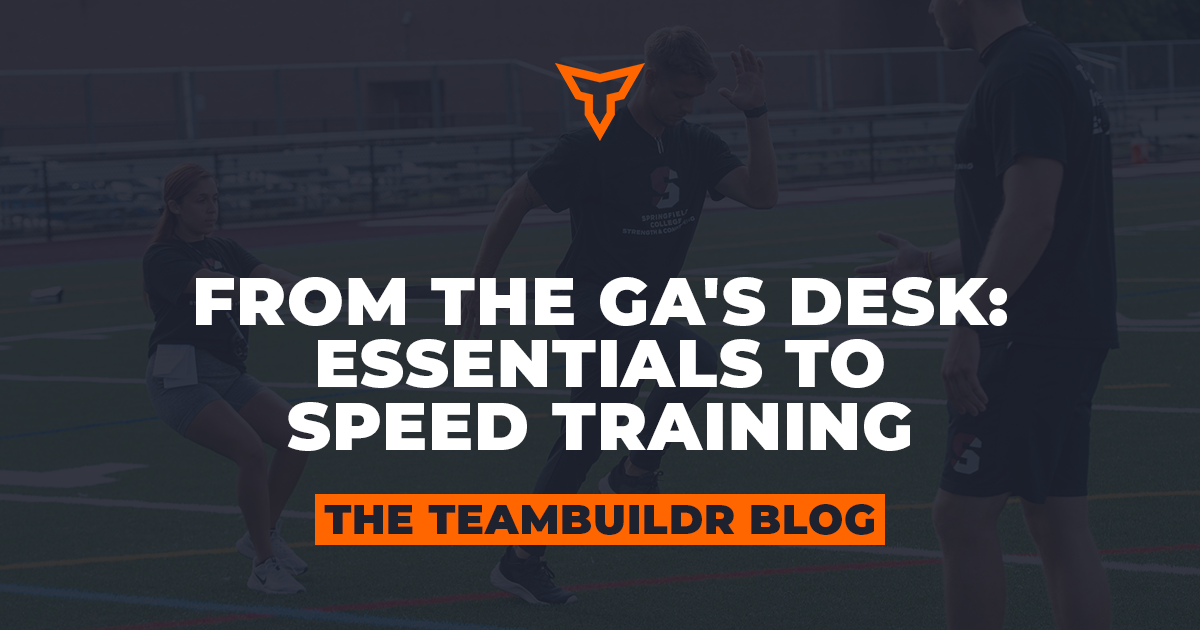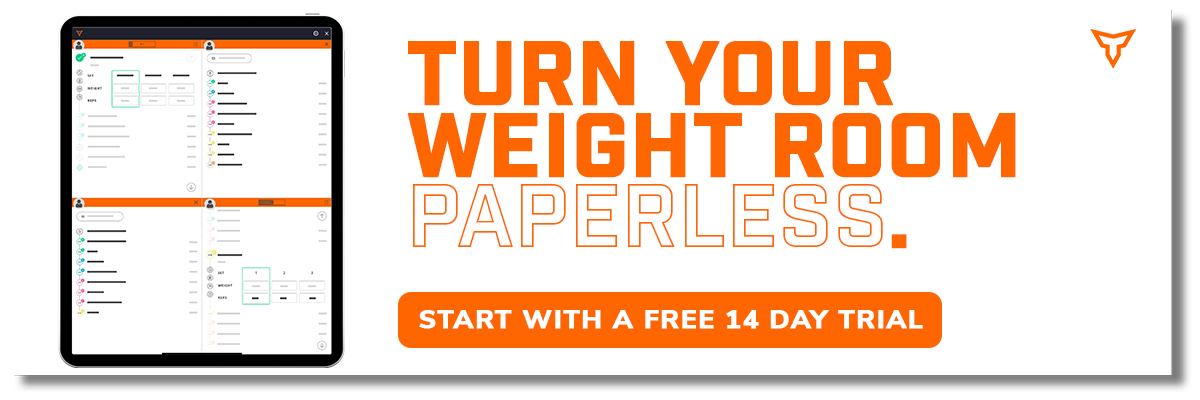Author Brian Szutkowski is a staff member at TeamBuildr in addition to his role as a performance coach specializing in track and speed development.
After coaching multiple different sports in the field of sports performance. I have learned many different things and seen different ideologies, methods, and programs when it comes to speed development. Here is a small list of knowledge I’ve collected over my years from those before me who have helped teach and guide as well as my experience in coaching to improve speed development and overall athleticism for the athletes you work with.
1. Control the Volume
When doing speed work, legitimate speed work, volume can quickly overload an athlete and ruin not only the session but the rest of the cycle you are currently working on. The more demanding something is, the more we have to look to control variables that can decrease the quality of work being done. For example, tempo runs for aerobic development aren’t nearly as intensive as a 30-meter fly or a 100m sprint, so you can do more of them. But as we get faster and faster and the outputs increase, overall volume must decrease. When it comes to timed fly's with a run-in, I usually stay ~300m in volume. When I am leaning more towards speed endurance sessions, I stay under or around 600m in volume. I understand many field sports such as American football use yards instead of meters so I would define a high-intensity speed session as under 300 yards and when it comes to agility/ conditioning, understanding the volume that is performed in-game per position and reverse-engineering the demands of sport to create the practice structure.
2. Understand Posture
I want to state I don’t like forcing all athletes to sprint the same exact way, the body is going to self-organize to try and be as efficient as possible, especially in any kind of fatigued state. I’d like to think of athletes like artists, and you wouldn’t tell DaVinci to change his brushstroke because it doesn’t fit what you think to be perfect, but if you could get him to lift his elbow so he doesn’t smudge the painting you would try. That’s like posture is in sprinting, don’t change everything, but try to make the individual model as efficient as possible. Posture plays a large key to speed development. Acceleration posture looks far different than top-end posture. For instance, during acceleration, the center of mass is in front of the body and there is a predominant forward lean with a piston-like motion of the legs. Then as the athlete gets more upright for max velocity posture, there is front side mechanics with relaxed shoulders while the center of mass is above the hip and the foot strike directly below the hip.
3. Mesh with the Weight Room
I love the idea of consolidating stressors and by that, I mean sprinting and lifting on the same day instead of alternating days. Both are taxing on the neuromuscular and central nervous systems. Running back-to-back intense days will not only increase the risk of injury but overall, the fatigue will lower the quality of work being done. The sprint times will be slower, the gym numbers will be lower and the athlete will eventually get to the level of overtraining faster. On a higher level, I love the idea of doing knee dominant movements in the weight room on days where acceleration or change of direction/agility are what's being done on the track/court/field while more top-end speed pairs more efficiently with hip dominant movements.
4. Understand Rest Times
Work to rest ratios and rest times are talked about all the time in a variety of different ways. Some say 6 seconds for every meter/yard or 1 minute for every 10, others maintain the 1:10-12 work to rest ratio meaning you should rest 10-12 times as long as you worked to establish full recovery. Either of these can be a great frame of reference for sprint training, the main enemy is incomplete recovery. If your athletes are regularly panting prior to starting the next rep in max speed training, we’re not getting the desired training effect. Tired does not equal productive. Coaches like Tony Holler and his “Feed the Cats” training program emulate that in that fatigue is not the goal, it’s the enemy. We want to go fast, and then rest long and recover, the shorter we cut the rest times, the more we run the risk of injury, create more of an aerobic adaptation and lose out on the quality of the reps being done.
5. Don’t Over Drill
Drills CAN be useful, but over drilling can task time away from more important things like actually sprinting and also mess up natural movement patterns with the athletes. Some of the times we can try to make someone so “perfect” that it makes them robotic and stiff. The other thing to take into account is that although it may LOOK similar to sprinting, that doesn’t mean it is. In the wall drill, for example, athletes tend to want to make fast switches, but fail to put force into the ground. But when they sprint, they want to put force into the ground to propel their bodies forward in motion. If this is the case, then how would you justify something in the program that isn’t really helping the end product improve?
6. Record, Rank, Publish (Feed the Cats)
Fostering a healthy and competitive environment for athletes to push themselves is almost a necessity to drive intent. One of the best ways to do this is to emphasize easily measurable exercises that can be worked into training. Timed sprints such as dashes and flys are awesome to utilize in training because they are a big bang for your buck and a lot of stimuli can be achieved from just a couple of reps with adequate rest. Utilizing a tool such as a Brower timing system, dashr, freelap, swift, or Vald SmartSpeed can get multiple athletes through the session effectively and efficiently. Athletes seeing where they stack up against their team or others will naturally want to perform better which will drive competition and increase performance and outputs.
7. Understand High vs Low Central Nervous System Output
Knowing what constitutes High-intensity days and Low intensity and how to structure a week will help improve your program. Not having high days back-to-back to allow recovery can increase the quality of work being done on the high days. Sprinting over 90% of your best effort, max strength training, power training or intensive/shock plyometrics are all high-intensity activities. Aerobic training (under 75% of best effort), extensive plyometrics, and mobility training can all be constituted as low actives. Competitions are high days, and in training typically you can have up to 3 high days in a 7-day period to be staggard with low days.
8. Don’t Over Condition/Utilize Conflicting Energy System Demands
There is always the coach that worries “we’re not in shape” or “we’re not fit enough”. I’d like to make the argument that your athletes are just not fast enough and are operating too close to their max output to make it repeatable. The answer isn’t to do more conditioning, it’s to get them faster. The idea of Speed Reserve is that the higher the ceiling, the better the floor. So, if an athlete can move regularly at 11 m/s, then them operating at 80% of that is going to perform better than an athlete that can achieve 10 m/s trying to maintain repeat power ability at 80%. By becoming faster, the speed reserve allows the athlete to outperform others with less effort and be able to repeat it over and over because it is not as fatiguing.
There is plenty more out there to help create the best individual program for each scenario and there is no one size fits all approach. But taking note of these common themes and utilizing them in your program can drive performance and keep the athletes healthy and happy while having the tools to be more successful overall.
Subscribe to our blog
Subscribe to receive the latest blog posts to your inbox every week.
Related posts

From the GA's Desk: Essentials to Speed Training

Program Culture is Built on the Field


